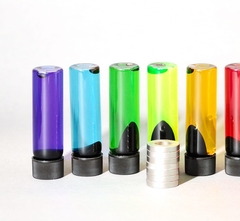Global Scans · Nanotechnology · Weekly Summary

- [New] TSMC is currently using the age-old FinFET process for its N3 (3 nm) process, but it's expected to transition to nanosheet GAA transistors when it begins production at 2 nm in 2025. ExtremeTech
- [New] The convergence of nanotechnology and climate technology presents a transformational opportunity to enable the big transition of the global energy system. pv magazine International
- [New] The Intel 14 A process will enable laser beams to carve transistors on silicon with a resolution of just eight nanometers, a significant improvement over the 13.5-nanometer resolution characterized by the Intel 18 A process. SiliconANGLE
- [New] The nanotube synthesis plant will have an initial capacity of 60 tonnes / year, increasing to 120 tonnes / year by 2026. compositesworld
- [New] Graphene nanotubes manufacturer OCSiAl (Luxembourg) will begin production in its new facility near Belgrade, Serbia in 2024. compositesworld
- In the previous earnings call, TSMC announced its plan for the new US fab to commence mass production using the 4-nanometer process in the first half of 2025. TrendForce Insights
- TSMC expects to start HVM using its N2 process technology that uses gate-all-around (GAA) nanosheet transistors around the second half of 2025. AnandTech
- A nanowire-on-micropillar hierarchy structure, similar to SEC-based separation, might be made by imprinting nanowires made of porous silicon onto the walls of the uniformly spaced micropillars. BioMed Central
- The improvement of antibacterial properties might be achieved through the incorporation of chitosan or other natural polymers, as well as inorganic materials such as copper and zinc nanoparticles. phys.org
- Nearly one in two Canadians would prefer the next federal election take place before 2025, according to a recent survey conducted by Nanos Research. CTVNews
- The global Lipid Nanoparticles Industry size will be valued at US$ 887.2 million in 2023. PharmiWeb.com
- The flexible, electrically insulating nanomembranes developed by Fraunhofer U.S. have the potential to reduce the local heat load of electronic components, such as current regulators in electric motors, by a factor of ten. phys.org
- Zelenograd Nanotechnology Center (ZNTC JSC) - a resident of the special economic zone Technopolice - will open the first Russia in the experimental line for the production of crystals of transistors based on gallium nitride (GaN-Si). TAdviser.ru
- The flexible, electrically insulating nanomembranes developed by Fraunhofer USA have the potential to reduce the local heat load of electronic components, such as current regulators in electric motors, by a factor of ten. Fraunhofer-Gesellschaft
- Consumption of urea will be lower by 2.5 million tonnes in fiscal year 2024 due to rising use of domestically-made alternative nano urea. Yahoo Finance
- The trend of increasing use of nano urea will further bring down the consumption of urea, which is in line with govt's goal to achieve self-sufficiency in urea production by 2025. Times of India
- On the horizon, High Earth Robotics plans to create the Argus constellation - twelve optical 6 U HERO-1 nanosatellites with space telescope payloads in GEO that can identify objects, take high resolution images of damaged satellites, and help identify solutions to avoid further decomposition. NASA
- American consumers can now eliminate the risk of devastating e-bike battery fires after Nanotech Energy's inherently safe 18650 cells went on public sale through its commercialization partner Voltaplex. The FPS Review
- Over the next 3 to 5 years, China is expected to add nearly as much new 50-180 nanometer wafer capacity as the rest of the world as well as construct 26 fabrication plants through 2026 that use 200-millimeter and 300-millimeter wafers - 10 more plants than in the Americas. War on the Rocks
- Highly acknowledged by the National Cancer Institute for its paradigm-shifting opportunities, the use of nanotechnology in cancer underscores the potential to construct theranostic nanoparticles from nanomaterials, enabling efficient targeted therapy. OUP Academic
Last updated: 28 April 2024
